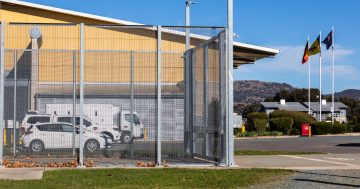
While the closest most people get to a prison is through a fictional TV series like ‘Prison Break’, life is far different for Prisoners Aid ACT President Hugh Smith and Vice President Shoba Varkey.
They help prisoners and their families every day – Hugh has for 45 years and Shoba for 17.
They also tell a different story. It is one of prisoners often coming from very disadvantaged backgrounds with low education, poor health, poor literacy and addiction problems. It’s also the story of the struggles faced by the families they leave behind.
Those that go into prison are often already at a disadvantage in society, said Prisoners Aid ACT President Hugh Smith.
“They are often behind the eight-ball in education, health in addictions and all those sorts of problems,” said Dr Smith.
“Prison itself is a chance to equip them with some resources. And it’s also important they get some help when they come out, to get back into society,” he said.
Prisoners Aid ACT is a charitable organisation operating since 1963 to support prisoners while they are in jail and on their release, as well as supporting their families and visitors.
They also provide a Court assistance and referral service (CARS) and welcome volunteers to assist.
Dr Smith has been involved with Prisoner’s Aid ACT for 45 years.
Over these years he has gained an insight into the workings of prisons, and the effect being in prison has on prisoners and their families.
“People go into prison with all sorts of disadvantages. Some are addressed while they are in prison, in the form of rehabilitation,” said Dr Smith.
“A lot of those that go in [to prison] do have a drug problem, or an alcohol problem or a mental health problem,“ he said.
“There’s often low education levels or poor literacy. There’s often just poor general health.”
“But even when they come out [of prison] they still have a lot of disadvantages.”
Dr Smith said even after they have served their prison sentence they are often punished because there is often a natural discrimination against someone who has been a prisoner.
He said we are often not aware of some of the wider impacts of someone being imprisoned. It can also be difficult for the whole family, especially if the offender is the main income earner.
“Suddenly they are short of money because their father or husband has gone [to prison]. There’s no income. They struggle to pay the rent and electricity bill, maintain cars, pay kids’ school costs,” said Dr Smith.
“It affects children as well. They can be stigmatised because their parent is in prison,” he said.
When Canberra’s jail, the Alexander Maconochie Centre (AMC), was opened in 2009 it was designed to accommodate 300 prisoners and to meet human rights standards. In 2016 the centre was expanded to accommodate up to 540 inmates.
Dr Smith said the AMC is a complex prison that holds sentenced and remand prisoners, those still to go to trial. It holds males and females, low, medium and high security.
Some prisoners are segregated because they need protection or they are dangerous. There is no mixing of genders.
Prisoners can participate in a combination of education and therapeutic programs including anger management, in an attempt to address their offending behaviour.
“There are education programs and anger management, some work activities and there is now a laundry and a bakery run by prisoners to get them used to work and gain skills,” said Dr Smith.
However, in addition to addressing offending behaviour, prisoners often have other complicated factors that need to be resolved. When they are released they often don’t know where to start, he said.
Prisoners Aid Vice President Shoba Varkey has also been involved with Prisoner’s Aid ACT for 17 years.
Ms Varkey said her motivation to work with Prisoner’s Aid is a preventative measure, to prevent prisoners from re-offending and being locked up.
“When a person commits a crime, they do their time and then come out of prison. Often they come out of jail with no jobs, no accommodation, maybe no family,” said Ms Varkey.
“Should a prisoner have to pay for the rest of their lives?” she asked.
”We don’t want them to continue for the rest of their life doing their time.”
“This is why I would like society to show some compassion. Show some forgiveness.”
“Families play a vital role in the rehabilitation and reintegration of a person when they finish their sentence and they are back in the community. It’s vital.”
The AMC is only open from Wednesday to Sunday and visitors need to book in advance.
Prisoners Aid support prisoners and their families. They can visit prisoners inside the AMC. They also provide a Throughcare service to support an inmate until they finish parole.
Prisoners Aid has a part-time worker in the visitor’s area of the AMC to talk with families.
The Court Assistance and Referral Service (CARS) has an office in the Magistrates Court, Monday to Friday 9 am – 12:30 pm. Phone (02) 6257 4866 or email: info@prisonersaid.org.au.
Should a prisoner have to pay for their crime for the rest of their lives? What ways can we help transition prisoners back into society? Let us know what you think in the comments below.























